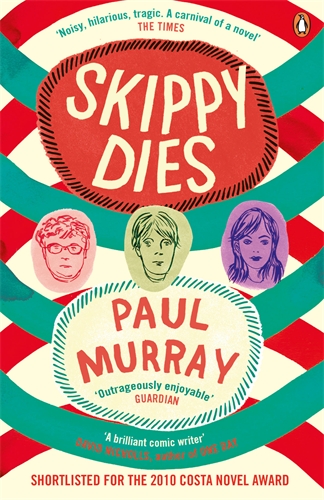This review is not only the hardest I have had to do because of the books length, but also because it concerns the best book I have reviewed so far, and I want to do it justice. That is not to take anything away from those other books that I have genuinely enjoyed, but as far as plot, originality and writing skills go, there can be no comparison to Paul Murray’s wonderful, Skippy Dies.
The book was longlisted for the Man Booker Prize 2010 and shortlisted for the 2010 Costa Novel Award, justifiably so. Well perhaps it did not gain full justification for how great it is; I have not read all the other books in the categories, but for it to not have been a winner there must have been some impressive opposition. It is set in a prestigious Catholic Irish boarding school called Seabrook College and primarily follows the lives of best friends, Daniel ‘Skippy’ Juster and Ruprecht Van Moren. The catch being that the novel opens with Skippy and Ruprecht having a doughnut eating contest, when Skippy drops off his chair and, not choking, dies whilst writing on the floor in doughnut jam ‘Tell Lori.’
Rewinding, the Seabrook story is unravelled through the eyes of countless characters, who Murray flits in between seamlessly, sometimes between paragraphs let alone chapters. This is not confined to children either, the story flows in other directions as we see events through the eyes of teachers like Howard ‘the coward’ and the mysterious Father Green, whose own backstory’s are as intriguing as the plot itself; Howard’s past interwoven in the tale. Having gone to a Catholic boarding school in England myself, also run by monks, there are interesting similarities to be drawn from this book – good and bad- and so anyone in the same position should find this equally as interesting.
As I’ve reached the topic I’ll continue. One of the reasons the book works so well is each character’s backstory is explored and developed so well that we really understand and appreciate their emotional state, and the reasoning behind any actions they might take. Murray leaves no stone uncovered as he reveals his characters’ pasts, family lives, and current issues. It allows us to begin to understand what each character is going through so that we aren’t left wondering why they are doing what they do.
Murray’s writing itself is excellent, thorough and stylish. He at once can be comic and tragic, tender when explaining life’s harshities, and downright dark. This is also where he succeeds so well; his ability to capture the teenage chat and banter. It would be easy for the dialogue between the group of boys to feel fake and contrived but this is never the case. At times it is carefree and loose but when he is delving into the darker parts, exploring drugs and prescription pill problems, it is hard and unforgiving. As is the book itself and its subject matter, some of the issues are very sensitive and the boldness with which Murray tackles them is commendable. It is plastered all over the book and any reviews written how funny yet tragic the book is and I’m just the next person to say it, but it really has to be said. It can be hilarious and tear wrenching. The format he uses is also daring, and it works. It is a risk to give the game away in your title and first chapter that the main character dies, but he executes the plot so well around it that you almost forget what is coming. But not quite… Knowing all the way through what devastation is waiting is very sad, because all the efforts and problems Skippy has are ultimately in vein, or simply unimportant.

Having earlier used Howard as an example praising Murray, to be slightly critical, for me it was when his problems and life were being explored that the book lost some of its pace, especially towards the end. I found him to be the hardest character to engage with and couldn’t find myself caring for him. That said, his character arc is very good… The same goes for Ruprecht, even though he is a main character and essential to the plot, I never really engaged with him as much as some other characters. However when his scientific experimenting is in full swing, it is jovial and shows the boys’ teenage camaraderie very well. But because there are so many characters, you are able to find your favourites and welcome it when the chapter concerns them; though admittedly it can be annoying having to wait for your favourite character to get a go.
Length is always going to be a discussed issue here too. At 660 pages it is not a quick, light read, but that shouldn’t put you off because it really is so brilliantly written. Sure, it could have done with 100 pages being knocked off but I suppose that would have compromised the books integrity to an extent. And I have read that Murray’s initial draft came in at about 1000 pages so we should be grateful that much got chopped off anyway. Once you get into it, the length won’t really come into your mind so just get into it and immerse yourself in the brilliantly created world of Seabrook. I’ll definitely be checking out more of Paul Murray, but for now, if you have the time and willpower, I really recommend this for anyone looking for some high grade modern fiction
★★★★★
You can buy it from Amazon here

